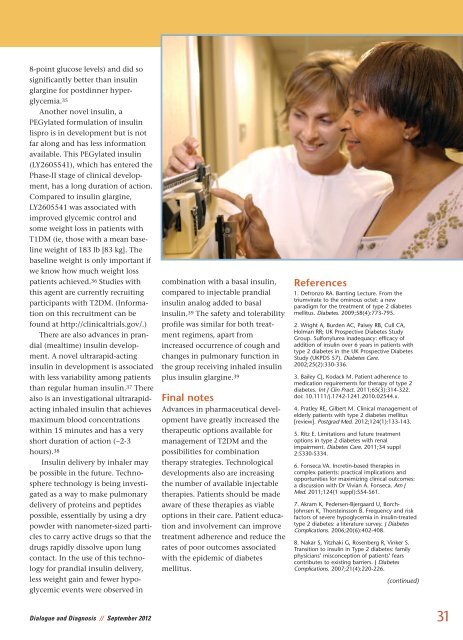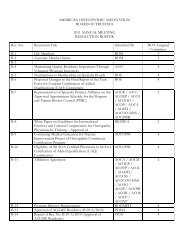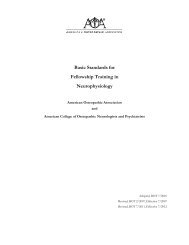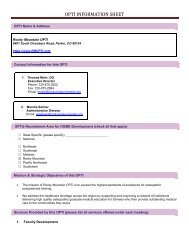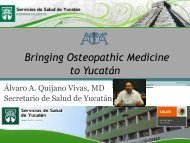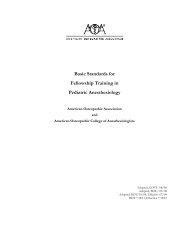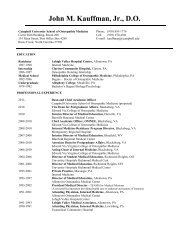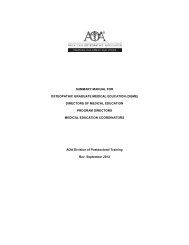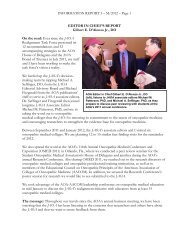Dialogue and Diagnosis - American Osteopathic Association
Dialogue and Diagnosis - American Osteopathic Association
Dialogue and Diagnosis - American Osteopathic Association
Create successful ePaper yourself
Turn your PDF publications into a flip-book with our unique Google optimized e-Paper software.
8-point glucose levels) <strong>and</strong> did so<br />
signifi cantly better than insulin<br />
glargine for postdinner hyper -<br />
glycemia. 35<br />
Another novel insulin, a<br />
PEGylated formulation of insulin<br />
lispro is in development but is not<br />
far along <strong>and</strong> has less information<br />
available. This PEGylated insulin<br />
(LY2605541), which has entered the<br />
Phase-II stage of clinical develop -<br />
ment, has a long duration of action.<br />
Compared to insulin glargine,<br />
LY2605541 was associated with<br />
improved glycemic control <strong>and</strong><br />
some weight loss in patients with<br />
T1DM (ie, those with a mean baseline<br />
weight of 183 lb [83 kg]. The<br />
baseline weight is only important if<br />
we know how much weight loss<br />
patients achieved. 36 Studies with<br />
this agent are currently recruiting<br />
participants with T2DM. (Information<br />
on this recruitment can be<br />
found at http://clinicaltrials.gov/.)<br />
There are also advances in pr<strong>and</strong>ial<br />
(mealtime) insulin develop -<br />
ment. A novel ultrarapid-acting<br />
insulin in development is associated<br />
with less variability among patients<br />
than regular human insulin. 37 There<br />
also is an investigational ultrarapidacting<br />
inhaled insulin that achieves<br />
maximum blood concentrations<br />
within 15 minutes <strong>and</strong> has a very<br />
short duration of action (~2-3<br />
hours). 38<br />
Insulin delivery by inhaler may<br />
be possible in the future. Techno -<br />
sphere technology is being investigated<br />
as a way to make pulmonary<br />
delivery of proteins <strong>and</strong> peptides<br />
possible, essentially by using a dry<br />
powder with nanometer-sized particles<br />
to carry active drugs so that the<br />
drugs rapidly dissolve upon lung<br />
contact. In the use of this techno -<br />
logy for pr<strong>and</strong>ial insulin delivery,<br />
less weight gain <strong>and</strong> fewer hypo -<br />
glycemic events were observed in<br />
combination with a basal insulin,<br />
compared to injectable pr<strong>and</strong>ial<br />
insulin analog added to basal<br />
insulin. 39 The safety <strong>and</strong> tolerability<br />
profile was similar for both treat -<br />
ment regimens, apart from<br />
increased occurrence of cough <strong>and</strong><br />
changes in pulmonary function in<br />
the group receiving inhaled insulin<br />
plus insulin glargine. 39<br />
Final notes<br />
Advances in pharmaceutical development<br />
have greatly increased the<br />
therapeutic options available for<br />
manage ment of T2DM <strong>and</strong> the<br />
possibilities for combination<br />
therapy strategies. Technological<br />
develop ments also are increasing<br />
the number of available injectable<br />
therapies. Patients should be made<br />
aware of these therapies as viable<br />
options in their care. Patient education<br />
<strong>and</strong> involvement can improve<br />
treatment adherence <strong>and</strong> reduce the<br />
rates of poor outcomes associated<br />
with the epidemic of diabetes<br />
mellitus.<br />
References<br />
1. Defronzo RA. Banting Lecture. From the<br />
triumvirate to the ominous octet: a new<br />
paradigm for the treatment of type 2 diabetes<br />
mellitus. Diabetes. 2009;58(4):773-795.<br />
2. Wright A, Burden AC, Paisey RB, Cull CA,<br />
Holman RR; UK Prospective Diabetes Study<br />
Group. Sulfonylurea inadequacy: efficacy of<br />
addition of insulin over 6 years in patients with<br />
type 2 diabetes in the UK Prospective Diabetes<br />
Study (UKPDS 57). Diabetes Care.<br />
2002;25(2):330-336.<br />
3. Bailey CJ, Kodack M. Patient adherence to<br />
medication requirements for therapy of type 2<br />
diabetes. Int J Clin Pract. 2011;65(3):314-322.<br />
doi: 10.1111/j.1742-1241.2010.02544.x.<br />
4. Pratley RE, Gilbert M. Clinical management of<br />
elderly patients with type 2 diabetes mellitus<br />
[review]. Postgrad Med. 2012;124(1):133-143.<br />
5. Ritz E. Limitations <strong>and</strong> future treatment<br />
options in type 2 diabetes with renal<br />
impairment. Diabetes Care. 2011;34 suppl<br />
2:S330-S334.<br />
6. Fonseca VA. Incretin-based therapies in<br />
complex patients: practical implications <strong>and</strong><br />
opportunities for maximizing clinical outcomes:<br />
a discussion with Dr Vivian A. Fonseca. Am J<br />
Med. 2011;124(1 suppl):S54-S61.<br />
7. Akram K, Pedersen-Bjergaard U, Borch-<br />
Johnsen K, Thorsteinsson B. Frequency <strong>and</strong> risk<br />
factors of severe hypoglycemia in insulin-treated<br />
type 2 diabetes: a literature survey. J Diabetes<br />
Complications. 2006;20(6):402-408.<br />
8. Nakar S, Yitzhaki G, Rosenberg R, Vinker S.<br />
Transition to insulin in Type 2 diabetes: family<br />
physicians’ misconception of patients’ fears<br />
contributes to existing barriers. J Diabetes<br />
Complications. 2007;21(4):220-226.<br />
(continued)<br />
<strong>Dialogue</strong> <strong>and</strong> <strong>Diagnosis</strong> // September 2012<br />
31


